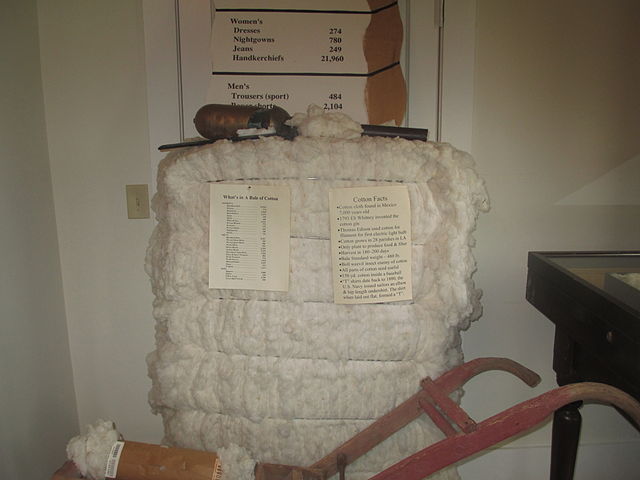Cotton bale
Compressed pack of cotton lint From Wikipedia, the free encyclopedia
Compressed pack of cotton lint From Wikipedia, the free encyclopedia
A cotton bale is a standard-sized and weighted pack of compressed cotton lint after ginning. The dimensions and weight may vary with different cotton-producing countries.[1]

A bale has an essential role from the farm to the factory. The cotton yield is calculated in terms of the number of bales.[2] Bale is a standard packaging method for cotton to avoid various hassles in handling, packing, and transportation. The bales also protect the lint from foreign contamination and make them readily identifiable.[3]
Bale management encompasses the systematic procedures of categorizing, blending, and assessing bales based on fiber attributes, with the aim of achieving desired quality yarn production at an optimized cost.[4] Cotton fibres differ in terms of staple length and other physical characteristics; this is an inherent feature.[5] Bale management, also known as "bale mixing," is the process of analysing, classifying, and then blending fibres from various bales [which also includes the bales received from other stations] according to their fibre properties in order to create yarn of a specific quality at the most affordable price.[6]
A "bale of cotton" is also the standard trading unit for cotton on the wholesale national and international markets. Although different cotton-growing countries have their bale standards, for example, In the United States, cotton is usually measured at approximately 0.48 cubic meters (17 cu ft) and weighs 226.8 kilograms (500 pounds).[7] In India, the standard bale size is 170 kg.[8][9][10][11]
The most important parameters of a cotton bale are:
Advances in standardization are reducing the variation in weights, sizes, dimensions, and densities of cotton bales.[8][14]
Candy is another trading unit. A candy weighs approximately 2.09 bales (356 kg).[15] In India, ginned cotton is traded in terms of candy also which weighs 356 kg (355.62 kg).[16][17][11]
When cotton is harvested and exposed to ginning, it carries more than 64% cottonseed, 2% waste and 34% fibrous matter (also known as lint).[18] Lower trash percentage in cotton increases the recovery.[19] Cotton bales are not pure cotton; they contain foreign contaminants, residual trash and leaf (and other non lint material) that have a direct impact on the recovery in yarn spinning.[20][21]
Seamless Wikipedia browsing. On steroids.
Every time you click a link to Wikipedia, Wiktionary or Wikiquote in your browser's search results, it will show the modern Wikiwand interface.
Wikiwand extension is a five stars, simple, with minimum permission required to keep your browsing private, safe and transparent.